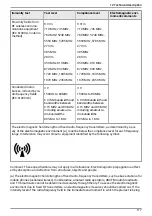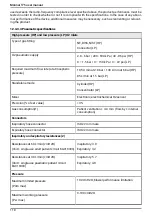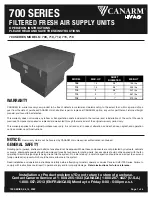
12 Technical description
M1
Membrane
V5
Bleed on/off solenoid valve (redundancy)
M2
Membrane
V6
Inspiratory phase control proportional sole-
noid valve
O2S
Oxygen sensor
V7
3/2 on/off patient venting solenoid valve
(MAP)
PR1
Pressure regulator (reducer):
CO2S
Carbon dioxide sensor
12.1.2 Ventilation operation
The blower (T) of the ventilator entrains ambient air via the microfilter (F1) and compresses it accord-
ing to the patient and the settings concerned. The compressed gas is then distributed via a pneumatic
network according to whether an inspiratory or expiratory phase is being delivered.
Inspiratory phase
The main component during the inspiratory phase is the solenoid valve (V6) which regulates the flow
rate via the flow sensor (FS3) when the selected mode is volume-controlled, or via the pressure sensor
(PS4) when the selected mode is pressure-controlled.
At the same time, the solenoid valves (V3), (V4) and (V5) are open, closed, and closed respectively
such that the blower pressure is applied to the membrane (M2) of the expiratory valve, thus forcing the
air sent via the solenoid valve (V6) to flow towards the patient only.
Expiratory phase
In this phase, the patient exhales the gases inhaled in the previous phase, and the unit is expected to
regulate to a pressure determined by the settings (PEEP).
With this in mind, the solenoid valve (V4) opens to depressurise the membrane (M2) and the PEEP
control proportional solenoid valve (V3) regulates the expiration pressure via the pressure sensor
(PS4).
At the same time, the inspiratory electromagnet regulates the flow via the flow sensor (FS3) for a rinse
flow of 3 L/min. This flow limits reinhalation and allows quick detection of an inspiratory demand.
Note:
During ventilation with leakage, such as NIV, the solenoid valve (V6) is liable to in-
crease the rinse flow; it then enters an “on-demand valve” mode. The purpose of this function
is to compensate for leaks in order to maintain the PEEP in the circuit.
Obstruction management
Version A:
In normal operation, solenoid valve (V7) connects the turbine pressure to diaphragm (M1), which plugs
the safety ambient air intake. If the patient needs to be vented to atmosphere, solenoid valve (V7) con-
nects diaphragm (M1) to the patient. On each inspiratory effort by the patient, the safety ambient air
intake opens and the patient can breath freely through the device.
Version B:
In normal operation, solenoid valve (V7) connects the turbine pressure to diaphragm (M1), which plugs
the safety ambient air intake. If the patient needs to be vented to atmosphere, solenoid valve (V7) con-
nects diaphragm (M1) to the atmosphere, which opens the ambient air intake and depressurises the
patient’s airways. In the special case of an obstruction in the expiratory limb, once the pressure in the
airways reaches atmospheric pressure, ventilation continues in accordance with the mode selected by
the operator. This is the backup ventilation system: the patient exhales through the ambient air intake
valve. Patient exhalation periodically occurs through the expiratory valve, to check how it is functioning
and permit normal ventilation when there is no longer an obstruction.
103
















































